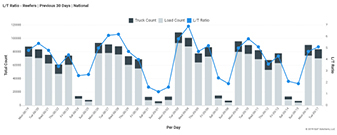|
By Mark Montague, Sr. Analyst, DAT Solutions
One of the most telling freight indicators is the load-to-truck ratio, which represents the count of loads posted compared to trucks posted in the spot freight market. A weak ratio foretells falling spot rates, while a strengthening number warns of tightening conditions.
In the middle of September, the national average ratio achieved for refrigerated freight rose, surpassing August's 4.48 ratio on eight of the first 10 business days in the month. While that sounds impressive, rate equilibrium for the refrigerated sector usually occurs from 6.0 to 7.5 load posts.
Still, the refrigerated freight spot market has been somewhat depressed, so what this is telling us represents positive movement on rates from the bottom. Indeed, on September 18, the national average spot reefer rate was $2.17 per mile, 3 cents higher than the August average. Contract linehaul rates are also up three cents per mile, comparing the same two months.
But it's worth noting that the average load-to-truck ratio in September 2018 was 5.9. And it was 10.4 in September 2017. The back half of 2018 saw falling ratios, it looks like the back half of 2019 will see ratios rise.
Why are load-to-truck ratios sitting at a relatively low 4.5 today? There's plenty of freight, especially in the Pacific Northwest's strong harvest of apples, potatoes and onions. Spot reefer volume in August increased 2 percent from July and was 6 percent higher compared to August 2018.
With the number of loads trending higher, much of the decline in the load-to-truck ratio can be attributed to an influx of capacity. Buoyed by last year's rate environment, strong volumes, and having made it through ELD implementation and enforcement, fleets added trucks and spot rates slipped.
In the coming quarter, three trends may affect the capacity picture.
First, tariffs and lower spot truckload freight prices resulted in an increase in trucking company closures this year. Donald Broughton, principal of Broughton Capital, tallied up the number of trucking companies that have gone bankrupt and says 640 freight companies have closed their doors in 2019, more than twice as many as went bankrupt in all of 2018.
"It's happening because costs went up last year as pricing power rose," Broughton said, noting that
|
 Rate equilibrium for the refrigerated sector usually occurs when the load-to-truck ratio is 6.0 to 7.5. It was in the 4.5 range in mid September, an indication that rates are favorable for shippers. Click to view larger.
Rate equilibrium for the refrigerated sector usually occurs when the load-to-truck ratio is 6.0 to 7.5. It was in the 4.5 range in mid September, an indication that rates are favorable for shippers. Click to view larger.
while spot prices have dropped dramatically this year, costs such as driver pay and expansion-related expenses have largely stayed at 2018 levels.
Some carriers closed for reasons that can happen even in the best of times.
New England Motor Freight of Elizabeth, N.J., said it couldn't attract enough qualified drivers in a tight job market, among other factors. Falcon Transport of Youngstown, Ohio, closed after its biggest customer, General Motors, shuttered a number of plants. LME Inc. of New Brighton, Minn., abruptly closed during a legal dispute.
Regardless, Broughton said this year's closures have taken more than 20,000 trucks off the road.
Second, trucks using older-style Automatic On Board Recording Devices (AOBRDs) will be required to switch to ELDs by Dec. 17, 2019. When first phase of the ELD mandate took effect in December 2017, it reduced capacity and led to a boost in rates that remained elevated through-out 2018. Broughton estimates that about 40% of the 3.5 million Class 8 trucks currently in use will be required to replace or upgrade the system they are using now.
Third, diesel prices are expected to rise after the Saudi Aramco oil facility attacks. Large carriers can compensate with fuel surcharges, but smaller spot-market-focused carriers have less cost-recovery ability. If fuel prices spike, truckload capacity will tighten further.
For now, ample trucks and lower rates are welcome news for shippers heading into the fall and winter holidays. Watch the load-to-truck ratios for an indication of which way the truckload freight market will swing. We could be in for a reversal of rate direction in spot markets in the near future.
Mark Montague is senior industry pricing analyst for DAT Solutions, which operates the DAT® network of load boards and RateView rate-analysis tool. He has applied his expertise to logistics, rates, and routing for more than 30 years. Mark is based in Portland, Ore.
|



